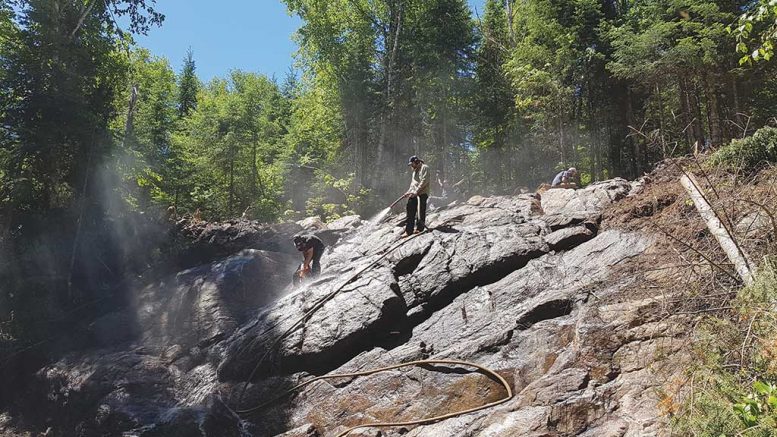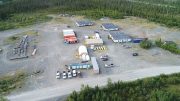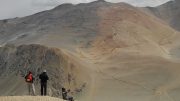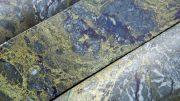Noranda was poking around 300 km north of Montreal, Que., in the 1970s when it drilled into what it believed was a skarn deposit grading around 0.5% copper, and walked away because it was too low grade.
That ground, now known as the Mitchi project, today belongs to Kintavar Exploration (TSXV: KTR), a junior explorer whose work over the last year has served up some pleasant surprises.
Kintavar says it has found a near-surface and folded sedimentary system in the eastern part of the property that can be traced for kilometre after kilometre, and displays characteristics that suggest the presence of a sediment-hosted, stratiform copper-type deposit.
“Instead of following the skarn model, we said we’ll trench the whole thing and open it up and see what’s there,” Kintavar’s president and CEO Kiril Mugerman says in a telephone interview from Montreal. “Once we trenched it, we realized we weren’t dealing with a skarn but with a sedimentary system, like those in the Democratic Republic of the Congo.”
But unlike those deep sediment-hosted stratiform copper deposits in the DRC, Mugerman says, copper mineralization at Mitchi is near-surface and shallow dipping, which means it could be mined as an open pit.
“Stratiform copper deposits are usually deep underground — none of them are exposed in an open-pit,” he says. “But ours is flat and shallow. It’s almost like a coal seam: long and continuous.”
In Mitchi’s case, it was high-grade metamorphism and folding of the Grenville rocks that brought the mineralization to surface. (The property is in the northwestern part of the Central metasedimentary belt of the Grenville geological province.)

A trench at the Mitchi copper property. Credit: Kintavar Exploration.
“Where we are, the unit is fairly thick by itself and folded, and because of the folding you have structural enrichment,” Mugerman explains. “Think of it as a piece of paper that is folded several times, and when you cut it, you intercept the paper several times.”
Initial surface work found copper and silver mineralization for over 20 km along three corridors — Watson, Sherlock and Nasigon — with grades ranging from 0.5% copper to 1% copper. Each corridor holds a bit over 10 km of favourable sedimentary units that are 5 to 7 km apart.
“The volume potential is huge,” Mugerman says.
Last year, channel samples from Watson yielded 13.6 metres grading 0.54% copper, 5.29 grams silver per tonne and 0.57% manganese, and 3 metres of 0.61% copper, 6.02 grams silver and 0.53% manganese. At Sherlock, a channel sample returned 21.4 metres of 0.49% copper and 5.5 grams silver, and at Nasigon, 10 metres of 1.1% copper and 3.4 grams silver.
This year, Kintavar is undertaking a 10,000-metre drill program, and early results seem encouraging. Drilling in the Sherlock corridor has intersected over 100 metres of copper mineralization in four of 12 drill holes.
Highlights include a 120-metre intercept grading 0.34% copper and 2.90 grams silver per tonne from 9 metres downhole (including 30 metres of 0.61% copper and 3.76 grams silver from 99 metres downhole) in hole 17-3, and 0.31% copper and 2.85 grams silver over 131 metres from 44 metres downhole in hole 17-4. Another hole, 17-8, cut 206 metres of 0.18% copper and 1.65 grams silver from 4 metres down hole, including 22 metres of 0.52% copper and 5.62 gram silver from 43 metres downhole.
After those results, Mugerman says, the company was approached by a number of majors, and Kintavar met many of them at the Prospectors & Developers Association of Canada convention in March.
The company recently raised $10 million — half from Quebec institutions. Caisse de Dépôt took the largest position and became an insider, with a 16% stake for $3.8 million.
The junior explorer is tightly held, with less than 100 million shares outstanding (90 million fully diluted).
Geomega Resources (TSXV: GMA), which spun off Kintavar a year and a half ago, and is also run by Mugerman, owns 25%. Quebec funds own another 25%, and local investors — many of them people in the region’s forestry industry who live close to the project — own another 25%.
The 280 sq. km project, the southern part of which is 300 km north of Montreal, is accessible by a network of logging and gravel roads, with a hydroelectric power substation 14 km east. Mitchi is also just 50 km south of Parent, which has a railroad link to Rouyn-Noranda. The project has so much infrastructure, Mugerman likes to joke, that it even has a postal code.
Mugerman notes that there are under 10 known sediment-hosted stratiform copper deposits in North America, among them White Pine and Copperwood in Michigan, Spar Lake in Montana, Creta in Oklahoma and Redstone in the Northwest Territories.

Workers cutting a channel at Mitchi. Credit: Kintavar Exploration.
Traditionally, the Grenville province — which stretches from Labrador to Mexico — has not been considered a good place to look for them, he says.
“You need a sedimentary basin, but not every one of them will have the right conditions,” he says. “Underneath the sedimentary basin you need the right rocks that have just enough copper to be leached out, then you need the perfect conditions to precipitate it.
“They are not that rare — you find them — but the problem is they’re always too deep,” he says. As a consequence, they are not always economically significant deposits.
“The monsters in the DRC are unique because they are 5-metre-plus thicknesses at depths of between 400 and 600 metres, and grades of 3–10% copper, just unbelievable. Everywhere else they are not as thick or as high-grade.”
It’s still early days, but Mugerman wonders whether Mitchi could turn out to be a monster, too.
In the meantime, the company is getting a better sense of how to spot them in a Grenville setting, and is investigating more targets.
“We think there could be more.”






Be the first to comment on "Kintavar bets on Mitchi in Quebec"